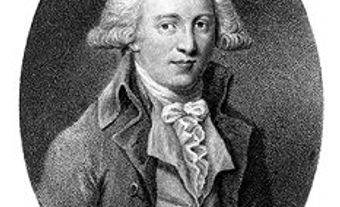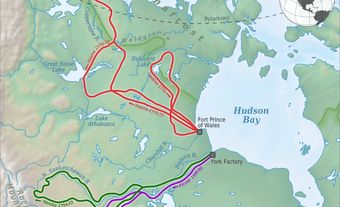
Louis Jolliet, explorer, cartographer, king’s hydrographer, fur trader, seigneur, organist, teacher (baptized 21 September 1645 in Québec City; died between 4 May and 18 Oct 1700 likely near Île d'Anticosti). The first significant Canadian-born explorer, Louis Jolliet achieved international fame in his lifetime as the first non-Aboriginal person, together with Jacques Marquette, to travel and map the Mississippi River. Jolliet also explored and mapped the Lake Superior regions, the area between the Saguenay River and Hudson Bay, and part of the Labrador coast.
Early Years and Education
The son of a wagon-maker, Jolliet entered the Jesuit College in Québec City in 1656. He studied philosophy, theology and music, and became an accomplished organist. His fellow students included Charles-Amador Martin, Pierre de Repentigny de Francheville and Germain Morin, with whom Jolliet shared the title of music officer. He took his minor orders in 1662 and completed a thesis in philosophy in 1666 while working as a cleric. He left the priesthood in 1667. Under the patronage of François de Laval, he sailed for France and spent 1667–68 in Paris and La Rochelle.
Mississippi Expedition
Following his return to New France, Jolliet became a coureur de bois. He was in Ste-Marie du Sault (now Sault Ste Marie) on 4 June 1671 and was one of the signatories of the treaty between 14 Aboriginal nations and Simon-François Daumont de Saint-Lusson that granted France possession of the territories of the West.
In 1672, Jolliet was chosen by Intendant Jean Talon to lead an expedition to determine whether the Mississippi, known from Aboriginal accounts, flowed into the Gulf of Mexico or the Pacific Ocean. Accompanied by six others, including Jesuit Father Jacques Marquette as translator, Jolliet set forth on the expedition in May 1673 and reached the mouth of the Mississippi on 15 June. In mid-July they had reached lat. 33°40´ N near the mouth of the Arkansas River, sufficiently far south to prove that the river flowed into the Gulf of Mexico. They turned back when friendly Aboriginals advised them that going farther would expose them to hostile Aboriginal and Spanish forces.
Jolliet returned north and spent the winter of 1673–74 at Ste-Marie du Sault. On his journey to Québec City in May 1674, all three of his companions were killed and his log-book and map of the Mississippi expedition were lost when their canoe capsized over rapids. Copies of the log-book and map left with the Jesuits at Saint-Marie falls were lost in a fire. However, in 1675, working from accounts by Jolliet and Marquette, Jean-Baptiste-Louis Franquelin drew a map of the expedition that was published in Paris in 1681 under the title Voyage et découverte de quelques pays et nations de l’Amérique septentrionale.
Hudson Bay Expedition
Upon his return to Québec City, Jolliet was denied a fur concession he sought for the Illinois area and joined his father-in-law in 1676 in a fur-trading company at Sept-Îles. Jolliet became seigneur of the Ȋles de Mingan in the Gulf of St Lawrence in March 1679, and of Île d'Anticosti in 1680.
In April 1679, at the behest of officials in Québec City, Jolliet embarked on an overland journey to Hudson Bay to survey the influence of English traders in the region, and to assess the possibility of a trade alliance with Aboriginals in the area. His reputation preceding him, Jolliet declined an offer from English Governor Charles Bayly to come and work for him, but became convinced that “if the English are left in this bay they will make themselves masters of all the trade in Canada.” Upon his return, Jolliet recommended that the French “remove the English from this bay,” or at the very least, “prevent them from establishing themselves any further, without driving them out or breaking with them.”
Labrador Expedition
Jolliet then concentrated on trade and fisheries at his concessions, until two raids by the English in 1690 and 1692 dealt him a financial blow from which he never recovered. On 28 April 1694, with the backing of a Québec merchant, he set sail from Québec City aboard an armed ship with 17 men and travelled along the coast as far north as lat. 56°8´ N near present-day Zoar. In addition to fishing and trading with Aboriginals along the way, Jolliet took detailed notes of the coastline and its inhabitants and completed 16 cartographic sketches — the first recorded account of the northern Labrador coast and the most detailed description of the Inuit to that time.
In April 1697, Jolliet succeeded Jean-Baptiste-Louis Franquelin as teacher of hydrography at the Jesuit College of Quebec. He was appointed hydrographer to the king of France in 1680.
Music
Though more famous as an explorer and hydrographer, Jolliet was also one of the earliest practicing Canadian musicians. Evidence of his musical talent was reported first by Father Jérôme Lalemant, who wrote that on 1 January 1665 “Monseigneur the Bishop dined with us, and so did Monsieur Meseré [Maizerets]; and in the evenings we invited the Sieurs Morin and Joliet, our musicians, to supper” (Jesuit Relations, vol. 49).
Jolliet is said to have played both the harpsichord and the organ. It is possible, but not documented, that he performed on the organ purchased for Québec City in 1663 by Monsignor de Laval. At a memorial service in 1700, recognition was given to his “having played the organ in the Cathedral and parish for many years. Done without pay” (Louis Jolliet, p. 145). A document dating from 1720 also recognizes “the fact that he played the organ and had taught several people from the seminary to play.”
Jolliet's interest in music is also obvious from a “chant illinois,” noted on a journey in 1673, either by Jolliet or by Father Marquette. In his book, William Amtmann reproduces the notation of this “calumet song” in its manuscript form (French ed. only, p. 252), as it appeared in Bacqueville de la Potherie's Histoire de l'Amérique septentrionale (Paris, 1722) and refers to a long-standing 20th-century debate on whether Jolliet or Marquette transcribed the song, adding his own reasoning in favour of Jolliet. Amtmann also provides a musical analysis.
A version of this entry originally appeared in the Encyclopedia of Music in Canada.

 Share on Facebook
Share on Facebook Share on X
Share on X Share by Email
Share by Email Share on Google Classroom
Share on Google Classroom


